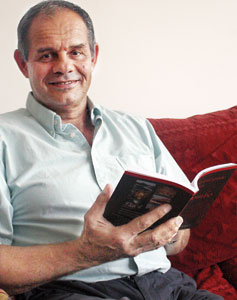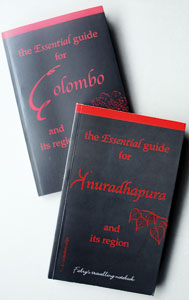Philippe Fabry’s travelling notebooks are as practical as they come. His no frills approach is based on his own preferences – “I am an individual traveller,” he says, “I want to go on my own, I don’t want a guide, I don’t want to be in a group, I want to be able to take my car or bicycle and just go.” He’s done so more than once – he’s travelled across the Sahara desert on a motorcycle and taken a boat expedition on the Ogoué River in the forests of Cameroon. He and his wife Lisa even raised two children aboard le Dragon de Maud – a prized yacht in which they sailed the Mediterranean Sea, the Red Sea, the Indian Ocean and the China Sea. This Frenchman will tell you though that Asia has been his great love.
 |
| Philippe Fabry |
He’s devoted nearly 25 years to exploring the vast continent. In India, he’s worked in exchange for his ticket on board the famous Palace on Wheels and crisscrossed Rajasthan atop an irate camel. In Pakistan he made a documentary film about the Indus and wrote a book to accompany it, a process that involved travelling thousands of kilometres on the track, deserts and water courses of Pakistan, Central Asia and Tibet.
Today, his wandering feet have finally found a place to call home – “We came for six months and stayed for 15 years,” he tells me, explaining that he and his wife, Lisa, chose to raise their two children in Sri Lanka. During that time they have travelled extensively, often setting aside weekends and public holidays for family trips. “We’d leave at 4 o’ clock in the morning...we travelled all over the island,” he says, remembering visiting Passikudah in ’97 and Jaffna as soon as the A9 opened in 2002.
In recent years, he’s begun to compile all that knowledge into a series of ‘notebooks’ meant for other adventurers. For such as Philippe, exploring the island comes with its own set of challenges, among which the language barrier appears to be the most daunting. Observing that many street names and directions appear in Sinhala only, if at all, Philippe says, “my concept has been for each site to give to the reader or the individual traveller all he needs to be able to find that place on his own.” He has already covered Jaffna and Anuradhapura as part of his travelling notebook series, and his latest – ‘The Essential Guide for Colombo’ – has just been made available on the shelves in local bookstores.
Philippe believes that Colombo is often underestimated as a tourist attraction. Speaking of the war years when tourists were scarce, he says “during that period the only visitors who were obliged to come to Colombo were really obliged to come to Colombo...but there are a lot of things to do in here and a lot of things to see,” he says, noting that his guidebook lists nearly seventy tourist attractions.
An intricate sketch of each location is accompanied by a brief write up, a map, GPS data, directions and the name of the place in Sinhala, Tamil and English – “so it’s impossible not to find.” A tiny heart on the upper right hand corner of some pages indicates that that particular site is a favourite with the author. Philippe has these details for over 2,000 locations across Sri Lanka logged into his database. Enough, he says, to write another 20 guides to Sri Lanka.
Once a photographer for the French agency Sipa, Philippe says the database grew out of his own need to keep track of various locations he had visited. (A book with some of his early photographs is awaiting publication.) On request, he shared those notes with friends who found them useful. The first set of notes was compiled into a book on Jaffna.
The format worked, and the Colombo guide adopts the same clear, direct layout. With the research and texts written in collaboration with Caroline MacDonald and Melanie Brehaut, the book includes many drawings and maps, the latter painstakingly created by Philippe himself.
In his introduction to the book, Philippe acknowledges that Colombo is not widely perceived as a tourist paradise. ‘But mind you,’ he writes, ‘if Colombo is today a busy, congested, polluted and noisy economical centre, it is mostly because it has been a ‘centre’ for centuries, a harbour capitalising on its strategic position and history.
There must be therefore, hidden, forgotten or neglected traces and remains of its long history and rich past.’ In the pages that follow, Philippe strives to live up to his promise to reveal such rarities to his reader. For instance, there is the relatively unknown ‘Thai Temple’ known as Sri Dipaduttamarama which is considered one of the oldest Buddhist temples in Colombo. Another section is devoted to the Whist Bungalow that Philippe notes is referred to in the writings of Tennent, Digby and Cordiner, and is so named for the secret whist games held there in the 19th Century by an English officer.
However, the vast majority of the book’s suggestions will be easily recognizable to someone who has lived in Colombo. “It’s purely from a visitor’s point of view,” says Philippe adding that he has eschewed other logistical details such as where to sleep and what to eat in favour of sites of interest. “The logistics are not my cup of tea,” he says, adding that his choice also means the guidebook remains relevant for a longer period of time.
A lot of thought has also gone into keeping the book more affordable than others of its ilk. The decision to use his sketches instead of his photographs was made, in part, for this reason. Still, you would imagine a photographer would opt for black and white photos as easily. For Philippe however, drawings are “more readable” than black and white photographs. “It’s more easy to see the essential characteristics of something,” he explains.
Like the others in the series, the book is published by Philippe’s own small publishing outfit, Viator Publications. It comes at a time when tourists across the world are discovering Sri Lanka and feel safe enough to venture here. Philippe says the appeal is clearly in the variety contained within this small island. “There is a kind of similarity for me between France and Sri Lanka – in France you drive fifty kilometres and you’ve changed region, customs, food, and it’s the same here,” he says, “you don’t have to go very far to have a different landscape and feeling and environment.”
Priced at Rs. 980 the book is available at Barefoot, Vijitha Yapa bookstores and Odel. |



